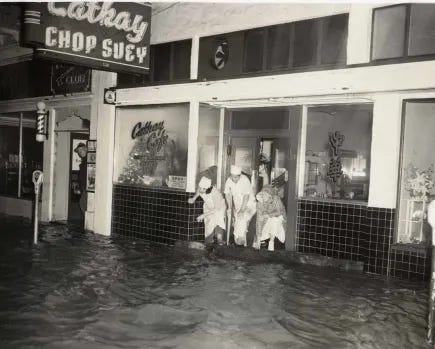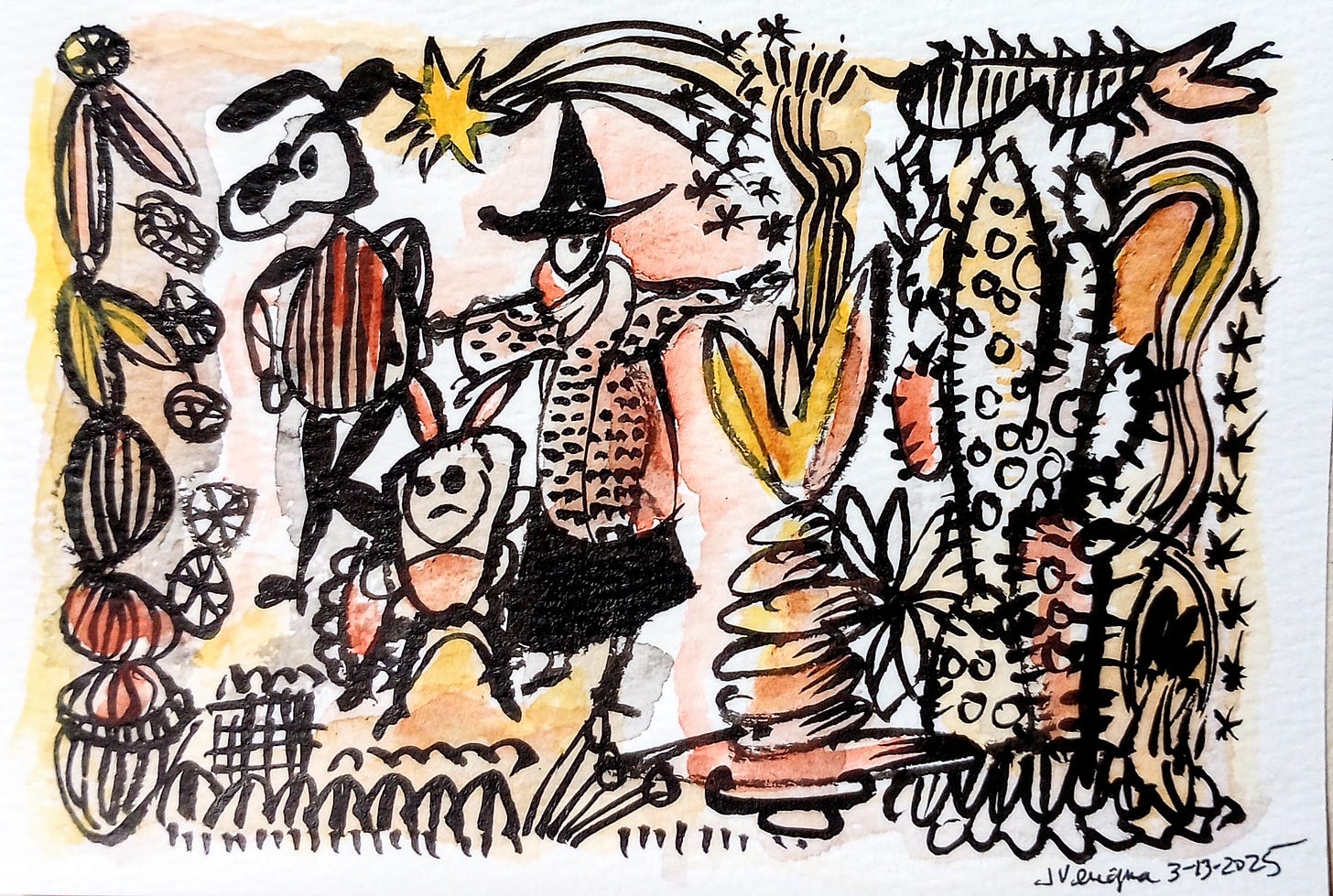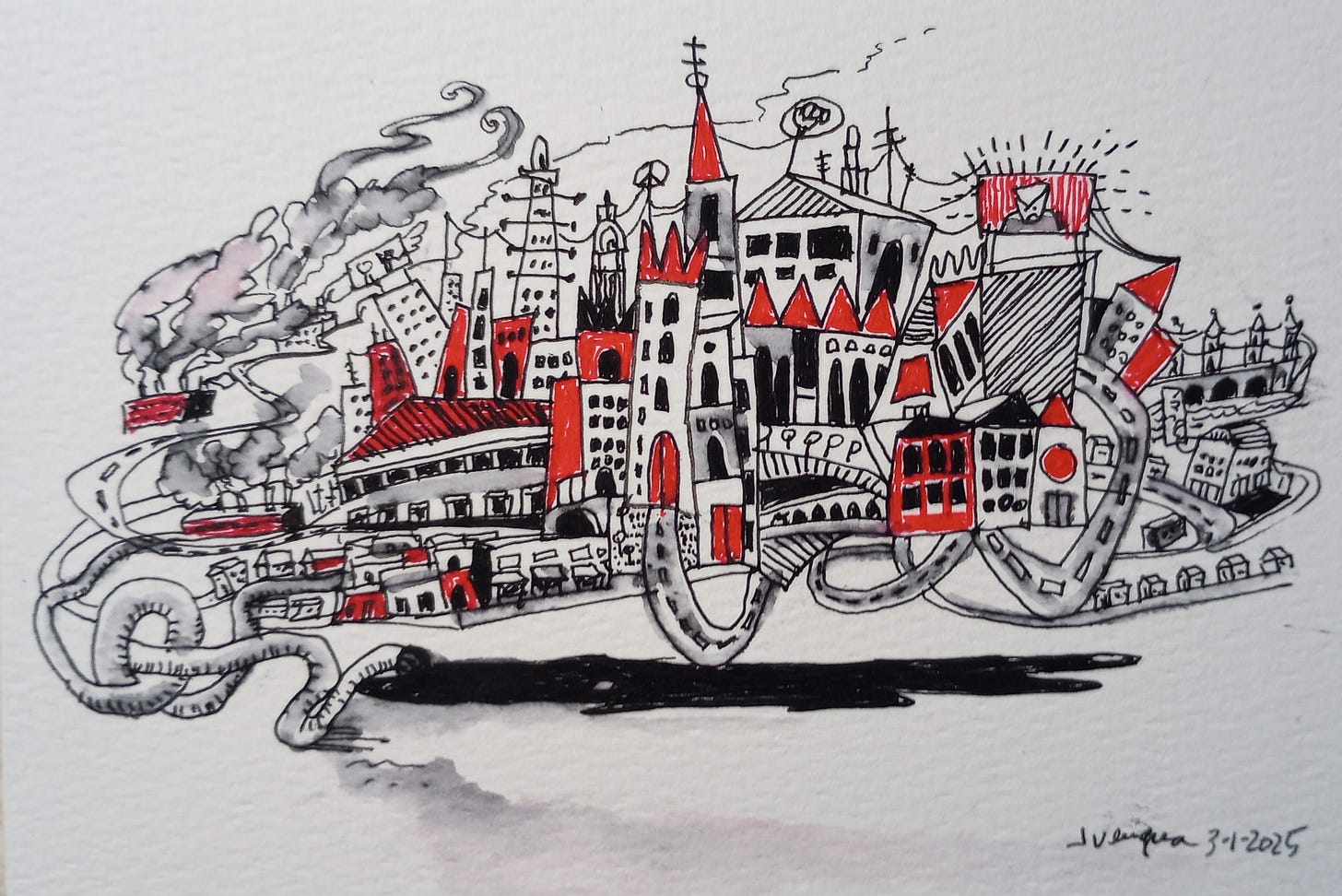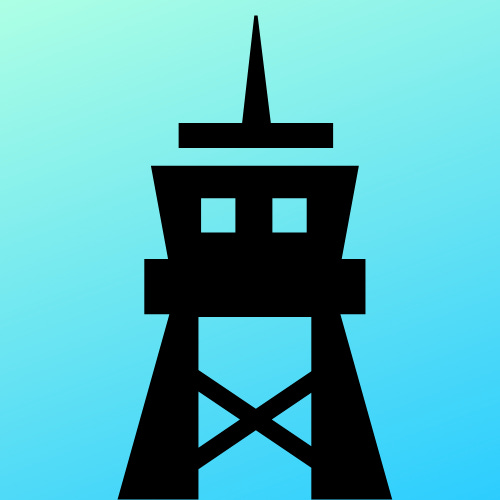The Flood of '55
#185: Flood of '55, more mail art, Jeremy Mathews' mourning pages, Rirkrit Tiravanija, and Sandra Mujinga; Alaskan Tapes and Luchs, Salin, and Grace Nono.
THEN & NOW
Some years ago, I sorted my parents’ letters by postmark date. Today I finally cracked the second big box of letters and found they are mostly from the 1960s. But there were a handful of envelopes from the 1950s in that box, so I transferred them to the 1940s-50s box. For now, I’m still going through the mid-1950s.
Except for letters from Dad focusing on the purchase of the house, there were few letters from 1955. Although I knew my mom was also writing to Dad, none of her letters seem to have been saved. Still, it was an eventful year, which started off with an accident for which Dad had to be hospitalized. He actually fell from the deck of his ship onto a (thankfully well-placed) life boat, and broke a couple ribs.
I remember that we picked him up in San Francisco (I think one of my godfathers drove us), and he spent some time recuperating at home. Yet, it wasn’t long before he was back working on a ship again. Without his paycheck, our mortgage would not be paid.
In December of that year, Santa Cruz experienced torrential rains for over 20 days, resulting in the great “flood of ‘55,” which devastated much of the downtown area, including Chinatown, as well as some parts of the east side. It was just one of many floods in the downtown area over the centuries. In 1954, the Army Corps of Engineers proposed the building of a levee system, but the flood hit before any progress had been made on that project.

I remember looking out the kitchen window at the gray skies and endless rain and asking Mom if we were going to have to seek shelter. How would we fare with no car? Would my dad’s brother Uncle Mike pick us up? The flood waters reached their high mark on December 22nd, and then all hell broke loose.
Fortunately our west side neighborhood was on high ground, compared to downtown’s flood plain, so we were lucky. This was not the case for folks on the other side of town. The video below by Daniel Model details the event, which includes interviews of local residents and their experiences.
Because of Dad’s work at sea, our little family was rarely together for the holidays. This was the case in 1955. Dad was again working on military ships, but this time they were bound for Guam and the Marshall Islands. In a letter dated December 22, 1955—the same day that the San Lorenzo river flooded downtown Santa Cruz— he wrote:
I certainly wish I could be at home with you to celebrate the Holidays. Anyway darling, that is off now. Let us only hope that next time we shall have a better luck to be celebrating Christmas together at home. Although I am away this time, I do hope that you would enjoy the holiday just the same with all the [trimmings].
He went on to describe the meager Christmas celebration aboard the ship, noting that the chaplain would distribute small packages to the passengers and crew. “It used to be a tradition of all the military ships, but I don’t know for sure this time. And if they do, you know, it doesn’t mean much. . . . of course there is nothing like when you are home setting [sic] around a Xmas tree with the family and friends.”
I haven’t seen any references to the 1955 flood in any of my parents’ letters. I suspect, however, that this holiday period was a particularly lonely one for Mom.
ART
I’ve been creating a lot of mail art. In some ways, it’s a new kind of “sketchbook” for me. Here are several postcards that will go out in the future. But first, I want to get an ink stamp pad so I can carve some rubber stamps for use on the address side of the cards.

RABBIT HOLE
Jeremy Mathews takes a refreshing (and critical) look at Julia Cameron’s book The Artists Way and considers “mourning pages” as opposed to “morning pages.”
Argentina-born Thai artist Rirkrit Tiravanija is known for his work in relational aesthetics. Below, he comments on the place of art and artists during these troubling times. I love the rabbit holes reference in the video!
And I think that paying attention now is actually a kind of political act. You know, it means a consciousness. I think that stopping, paying attention, and noticing things is really something significant—I think now when we’re in a place and time when there’s so much trying to ask for [your] attention. But the kind of attention they are asking for is a diversion from reality in a way; it’s a diversion from facts; it’s a diversion from truth.
Right now art needs to stop becoming property, or . . . yeah a kind of investment or tokens of investment. Art has to stop becoming commodified, and art has to kind of start going out and back into the woods, as it was—or as Duchamp said ‘it’s time for art to go underground.’ But to go underground isn’t to give up. It’s to kind of work in a different place for different reasons.
Also on the Louisiana Channel, Sandra Mujinga’s textile art focuses on the monstrous body.
I’m always aiming to be as free as possible, but I’m also creating a structure for that [freedom] to exist.
SOUNDINGS
Salin talks about her pioneering Afro-Thai music:
Salin: Thai funk to make the sugar cane grow:
Philippine singer and ethnomusicologist Grace Nono on singing and rites of healing.
You can hear Grace Nono sing “Salidumay” on her YouTube channel.
My gratitude goes to everyone who reads Eulipion Outpost regularly, and especially to those who have subscribed or donated on my Ko-fi page to support my efforts.
My ongoing appreciation goes to the Mysterious M. for his excellent editing skills.
Website and blog: Jeanvengua1.wordpress.com
A Crooked Mile (a blog)
CommonwealthCafe (Filipino American & AAPI history and print culture)
Eulipion Outpost is a reader-supported publication. To receive new posts and support my work, consider becoming a free or paid subscriber.








Growing up in Baguio, one would think there is no flooding in the mountains. Yet, every year, we had to trench our yard so water would flow downhill. Since it rains almost every day, grass grows thickly, and their root systems sometimes block the canals. During the monsoons, school was canceled, once for up to two weeks. Without power, we learned to entertain ourselves with Scrabble, chess, and reading!
Thanks for all the links. I will watch them later.